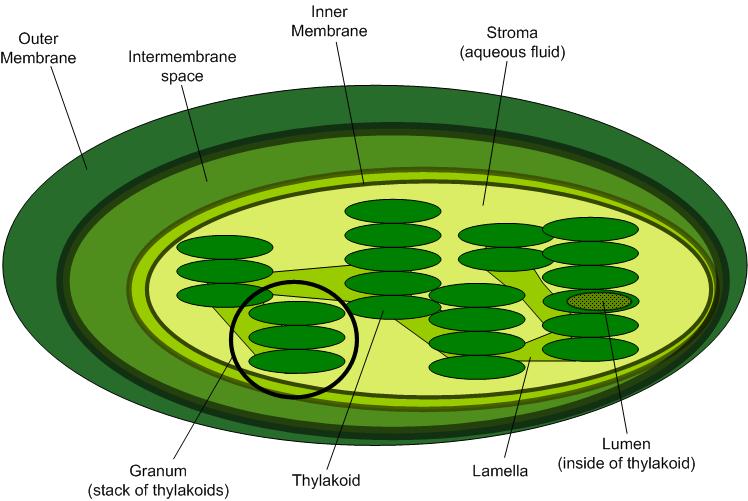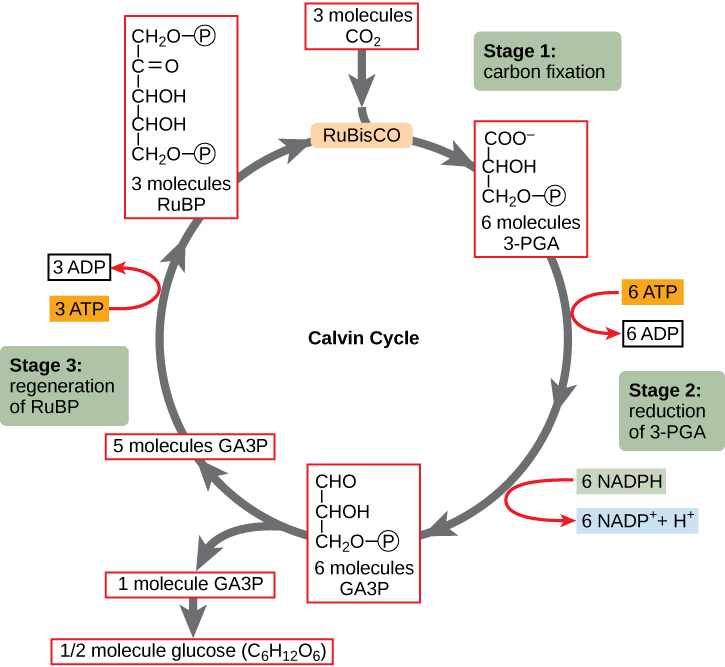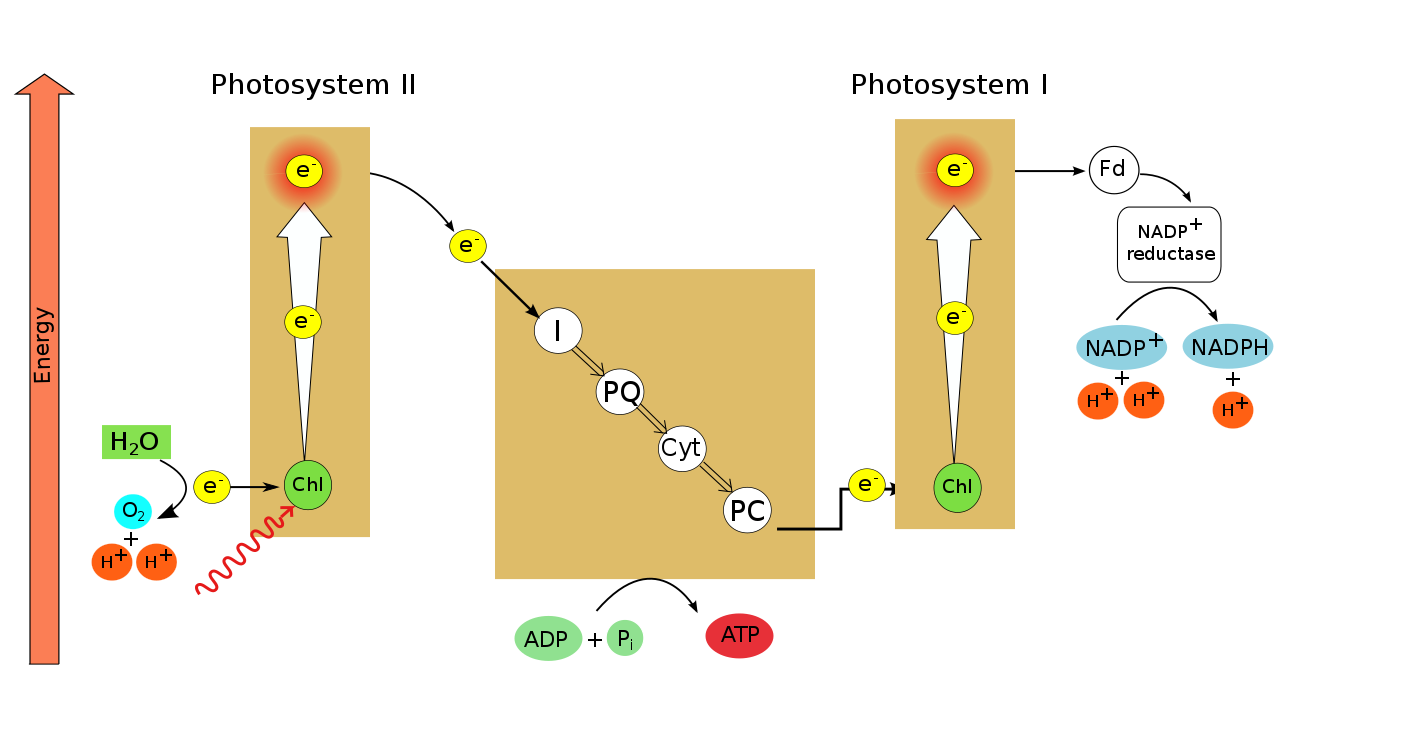We have seen how the body takes in energy and how it uses it. But before we can consume food to obtain the energy stored in it, that energy must have been stored there. This is the result of photosynthesis, which leads us to consider the chloroplast.
Chloroplast structure
Chloroplasts occur inside the cells of plants, like the nucleus or the mitochondria. Like mitochondria, they contain their own simple form of DNA, because, like mitochondria, they originated as bacteria which moved into another cell, felt at home and stayed. Within a double cell membrane, they have a number of closed membranes called thylakoids arranged in stacks, each of which is called a granum. There is fluid inside all these spaces; that inside the membrane and in which the thylakoids are arranged is called the stroma.

Chloroplast structure, from Wikimedia Commons
Photosynthesis takes place in two steps: light reactions in the thylakoid membranes and the Calvin cycle in the stroma.
- The light reactions use energy from sunlight in two ways: to store energy as ATP; and to transfer electrons to form NADPH. Both are passed to the Calvin cycle.
- The Calvin cycle uses the electrons and ATP plus CO2 from the air to make glucose.
The light reactions thus furnish the energy and the fuel used by the Calvin cycle.

The two steps of photosynthesis, from Openstax College
Light reactions
The light-reaction phase of photosynthesis is also called the Z-scheme, but since the Z usually is shown lying on its side, it looks much more like an N-scheme. Light reactions take place in three steps.
In steps (1) and (3), called Photosystem II (PII) and Photosystem I (PI),1For historical reasons, photosynthesis II comes before photosynthesis I. energy from light excites an electron in chlorophyll to a higher energy level. Since the most important form of chlorophyll, chlorophyll a, absorbs red and blue light but reflects green, leaves are most often green. Other pigments may absorb light of other frequencies and so give different colors. These other pigments (called the antenna complex) transfer any energy they absorb to the chlorophyll a in what is called the reaction center, which can thus collect energy from light of different wavelengths, extending the sensitivity range of the process. Only in the reaction center are excited electrons passed to the next phase.
Although Photosystem II and Photosystem I are similar in operation, they differ in a number of ways. For one thing, their reaction centers contain different pigments: P680 in PII and P700 in PI. (The P numbers refer to the wavelength in nano-meters of maximum light sensitivity of each pigment.)
In photosynthesis II, light energy serves two purposes.
- It forces a reaction-center electron to be released to the electron transport chain of the next step, an electron transport chain, like those in mitochondria.
- It also powers water photolysis, the separation of water molecules into O2, protons and electrons.
All this takes place inside the thylakoid membrane.
Each of the products of step 2 has its own destination. A small part of the oxygen is used by the plant’s mitochondria for energy, the rest is released into the atmosphere where, for instance, we breathe it. The protons serve in the next step. And the electrons replace the electrons lost by chlorophyll in step 1. This process is historically and evolutionarily quite old, having already taken place over 3 Gya in cyanobacteria, where the plentiful source of electrons was water.
Photoloysis, the breakup of water to yield electrons occurs as follows
2 H2O → 4 H+ + 4 e– + O2
I.e, four electrons at a time. But P680+ can only receive one electron. A process called the oxygen-evolving process exists which allows this to take place, but unfortunately, it is well beyond the scope of this document. Also, alas, it is not completely understood. If it were, it might enable us to extract hydrogen from water in an energy-efficient way, which could put an end to our energy problems.2It could also completely shake up the world economic and political situation, but that is way beyond the scope of this document.
The electron released by PII then goes through photophosphorylation, an electron transport chain similar to that in mitochondria, but now taking place in the thylakoid membrane of the chloroplast. At each step, some of the electron energy is used to pump protons across the thylakoid membrane. At the end of the chain, the electrochemical gradient of the protons across the membrane serves to turn ATP synthase which converts ADP into ATP by the process of chemiosmosis. So at the end of step 2, we have ATP and a free but weak electron.
PI again uses solar energy to kick an electron up to higher energy where it is released. This time, it can be replaced by the electron leaving the ETC. The electron released by PI has enough energy to go through a process which stores its energy on the electron carrier NADPH, a close relative of our old pal NADH. The solar energy is now stored in the NADPH and the ATP from the ETC and both move to the next step, the Calvin cycle.
In the light reactions, electrons and energy have different fates. Electrons from water wind up in NADPH; solar energy is transferred to ATP. So the overall effect of light reactions is to store solar energy in ATP for use by the plant or in the Calvin cycle, and to energize NADPH for the Calvin cycle. The complete chemical formula for the light reactions is the following.
2 H2O + 2 NADP+ + 3 ADP + 3 Pi + light → 2 NADPH + 2 H+ + 3 ATP + O2
Calvin cycle
The second step of photosynthesis, the Calvin cycle, takes place in the stroma of the chloroplast. It takes in CO2 and uses the chemical energy produced by the light reactions to make sugar molecules, usually glucose.
The Calvin cycles takes place in three stages, which are indicated in the figure.

The Calvin cycle, from Openstax College
In stage 1, carbon fixation, the enzyme whose “much-needed nickname” is RuBisCO3Kratz (2009), 197., catalyzes the reaction of CO2 and 5-carbon RuBP into a 6-carbon compound which immediately splits into two 3-carbon compounds called 3-PGA. Then, in the reduction step, ATP and NADPH from the light reaction photosystem I reduce 3-PGA to G3P. On each tour of the cycle, one G3P separates from the cycle and these molecules eventually (at the end of six tours of the cycle) form a carbohydrate molecule, usually glucose (C6H12O6). The other G3P molecule and ATP regenerate RuBP, so the cycle can begin again. So it takes six tours of the Calvin cycle to convert CO2 into glucose. The complete formula is therefore the following.
6 CO2 + 12 (NADPH + H+) → C6H12O6 + 12 NADP+ + 6 H2O
ignoring the energy from ATP going to ADP and Pi.
It is impossible to stress overly much the importance of these reactions. They are essential for life on Earth. Not only is our oxygen-rich atmosphere originally due to photosynthesis by cyanobacteria and stromatolites, the current maintenance of oxygen levels depends on it. And the very energy we run on, as we have seen in this chapter, comes from the glucose made in the Calvin cycle.
This is worth repeating.
- The Calvin cycles takes in CO2 from the air and uses the energy-rich products of the light reactions to form glucose and prepare for the next tour of the cycle. This cycle depends on the enzyme RuBisCO, which therefore is essential to life on planet Earth.
- We and other animals eat the plants – and other animals which have eaten plants. After breakdown of food by digestion, the glucose originating in photosynthesis is used by cellular respiration to provide energy in the form of ATP which powers our muscles, our neurons and other metabolic functions. The waste from this conversion is CO2, which goes back into the Calvin cycle.
- Light reactions use the energy from sunlight to take in water and break it down into O2, protons and electrons. The electrons are energized by light to go through chemiosmosis and form energy-rich products which are passed to the next step, the Calvin cycle.
Notice that CO2 is produced as waste in cellular respiration, then taken in by the Calvin cycle to be reconverted into glucose and O2. This process must remain in equilibrium
Now, on to more physiology subjects, this time about communication.



